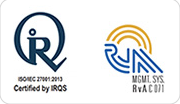Nearly three years ago, the International Accounting Standards Board published a new standard for lease transactions – the IFRS 16 – with the objective to “report information that faithfully represents leases transactions and provides a basis for users of financial statements to assess the amount, timing and uncertainty of cash flows arising from leases”. This regulation details the identification, measurement, demonstration, and full disclosure of most leases on the balance sheet to facilitate transparency of reporting[1].
As of January 1, 2019, this regulation will affect all US organizations that use rentals or leases to obtain assets. According to the current provision IFRS 17, organizations needed to present only financial leases, while operational leases could be kept off the books. However, with IFRS 16, there will no longer be any distinction between operating and financial leases. All organizations will have to declare both types of contracts (with the exception of short term leases less than 12 months long and without a built-in option of purchase of asset) as lease liabilities in their accounts, thus possibly significantly increasing their borrowing degrees. The IASB’s estimate is that 66x assets worth $3 trillion will join balance sheets and the sectors most likely to be impacted are logistics, retail, telecom, manufacturing, technology, and financial services.
The change will be momentous both due to repapering and the added manual contract review, and organizations will be forced to change the way they approach leases. Lucy Newman, Partner at Deloitte says, “It sounds very simple to put your operating leases on the balance sheet, but it’s actually very complex. In order to do that the standard requires a number of very complex calculations and a number of judgments within those calculations to actually get the numbers on the financial statements. That’s a huge challenge for finance functions.”Some are even calling the IFRS 16 a ‘leaseberg’ of huge proportions. But, as Jonathan Steel, global head of occupier solutions at BNP Paribas put it, it may be an occasion to “spring clean”. The standard may reveal contractual opportunities to the organizations, reminding them of ancient contracts, auto-renewals, and other areas that lead to loss of funds. Here’s How You Can Comply with IFRS 16
1. Finding your leases
The first step towards transitioning to an IFRS 16- compliant system would be to locate all your leases. This is harder than it seems since contracts are often scattered across several servers and file systems, and may be of various formats and languages. First, you need to find and reassemble these leases in a single contract repository to successfully extract essential information from the contracts. Be sure to include all leased asset types, look through all system architecture that could possibly hold your leases, understand all lease structures, and consider accounting policy decisions[2]. You will have to find lease portions of your contracts, identify operating leases, extract elements such as services, terms, renewals, and maintenance[3], and separate non-lease parts from lease parts. Using only spreadsheets for storing your contract information may not work anymore. Contract management technology can help alleviate these organizational woes. On the other hand, if your organization lacks the resources or expertise to create a cohesive contract management system, a cost-effective solution would be to use the capabilities of an outside vendor.
2. Tagging key data
Automating processes by using discovery and analytics systems to pull key contract data1 can save time by up to 80%. Once the contract repository is complete and key data extracted, attorneys should perform contract review with the aid of contract analytics software. Instead of locating and reading whole documents, and noting down information in spreadsheets, attorneys should be able to make determinations based on lease information, which will be stored as metadata. The contract review may reveal the need to restructure your contracts. Having the capacity to extract key data on a self-service, ad-hoc basis gives rise to a resilient contract management system that can tackle new requests easily1. Ideally, the end user should be able to edit the metadata without the use of codes. The user should have the facility to use existing contract language, give new labels, and train the system to trace fields across the whole contract repository.
3. Preparing reports
As current financial reporting tools may not cut it for IFRS 16, you may have to reevaluate them and decide if they can satisfy the new model. Your attorneys must be able to create customizable and exportable reports1 from the extracted lease information for your finance team to complete your compliance process. Industry experts have estimated that it takes six months to become IFRS compliant, making this transition a top priority. Restructuring your contracts and contract repository, and rejigging your contract analytics with up-to-date legal technology and outside vendor expertise will make sure you become compliant with this new standard.
LegalEase’s experienced compliance attorneys can help you navigate IFRS 16. LegalEase works with leading technology that allows you to search, sort, review, tag, and compare data, across your entire contract database. Our solution enables control over your contract universe, managing the risks and exposure associated with your business’s contracts and agreements. To stay compliant with this new regulation, please reach out to us at contact@legaleasesolutions.com. Our team will ensure you are ready and prepared for IFRS 16 by the time it rolls into action.
References
[1]https://www.accountingtoday.com/opinion/ifrs-16-compliance-presents-the-choice-to-be-outstanding
[2] https://blog.aptitudesoftware.com/how-to-prepare-for-your-lease-accounting-project
[3] (http://blog.mindcrest.com/because-contracts-compliance-wasnt-complicated-enough-introducing-ifrs-16: accessed November 21, 2018; site inactive on 5 April 2022)







